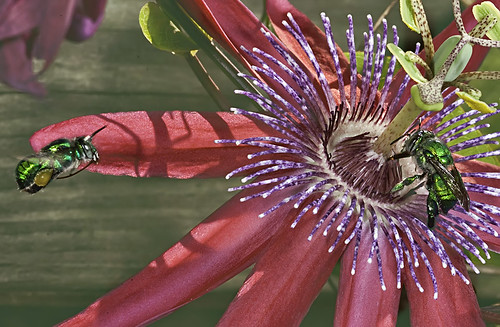Omniscent 0.96 (Yosh) is a nearly all-encompassing scent that is a little play on a potent word *, and defies categorization as it feels like a few perfumes in one. It's colourful, free spirited, comforting, familiar and yet at the same time intriguing and full of surprises.
It all begins with a shrinkingly familiar yet mysterious accord of aloe-vera hand & body lotion my mom used to have eons ago (and shared with me very generously), and Opium parfum combined. There's also the pink pepper note set against vanilla that made me fall hard for Ormonde Jayne’s Ta’if the moment I smelled it (but no roses or saffron here). If there is any basil in the top notes, it's only imparting a spicy, eugenol note that gives it that immediate "oriental" feel.
And there's also the thick, nearly overpowering presence of khus oil, which is a popular oil perfume from India that you would find in folk festivals or on Haight street (or Commercial Drive if you're in Vancouver - which is where I first found all those rich, oriental single note oils such as amber, Egyptian musk and Khus). It's not ruh khus (the traditional distillation of vetiver oil), and it's also not cannabis or vetiver fragrance oil, but kind of a mix of both, which eventually smells just very sweet, woody, rich and intoxicating.
Floral notes are lurking in its midst - big ones such as gardenia, tuberose, and also the quieter, soapy and demure lilac, accompanied by milky, powdery fig accord. But it is by no means floral – these notes rather amount to an abstract, imaginary orchid impression, something that might have been taken out of a mother-of-pearl tinted floral illustration of lotus and peonies on a lacquered Chinese treasure chest. Sandalwood fans in the background release a creamy-woodsy scent that weaves in and out whenever it gets a chance to peak through the stronger personalities involved.
A couple of hours in, the vanilla gets amplified, and it slowly mellows down until the drydown, which is subtle and delicious: sandalwood, vanilla, musk and patchouli, staying close to the skin and having a sensual, dry-yet-sweet appeal that is perhaps what I like the most about Omniscent. This phase will last through the day (or night) and feels like its has a very clean finish.
Omniscent nearly escapes the completely headshoppy categorization simply because there is more to it than just this one single note or another. It has evolution and tells it's story in the Yosh style - which I came to know as free spirited, and humorous: it never takes itself too seriously, this way or another, which leaves just enough room for you to create your own narrative if you wish.
You can find Omniscent at Barneys, Scent Bar or online on LuckyScent.
This review is for the eau de parfum, which is lighter and less dense and dark than the parfum oil (in the numbered flacons).
Top notes: Aloe Vera, Basil, Pink Grapefruit, Pink Pepper
Heart notes: Tuberose, Gardenia, Lilac, Fig, Violet
Base notes: Sandalwood, Vanilla, Musk, Khus, Patchouli
* Omniscient means having total knowledge, knowing everything, and is often one of the attributes of God.



![Sweet William by Diesel [papersnapdragon.co.uk]](http://farm7.staticflickr.com/6131/5997606220_8d08b46990.jpg)


